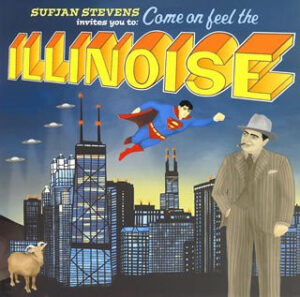
Sufjan Stevens, “Come on feel the Illinoise”, https://www.discogs.com/release/11600735-Sufjan-Stevens-Illinoise
2A) I have used other creatives work on a few projects; most of the projects consist of using photos from a photographer. Some of these design pieces would be a social media post in which case the photographer would just ask to be tagged in the post and make sure we put who took the photos. When it comes to using a photo, you must think about exclusive and non-exclusive photos. An exclusive photo is something a company or person said cannot be used for your personal work. Using an exclusive photo can get you in a lot of trouble.
There was case called Sufjan vs DC in which an exclusive photo was used, and the person did not get in trouble. In 2005 Sufjan Stevens released Illinois, his second “state concept album,” it was an album where all the songs on the album are related to a specific state. It did well when it released. In the CBR article it stated “However, when the album was suddenly pulled from stories, people believed that DC had taken issue with the whole “unlicensed usage of their trademarked character” aspect of the cover (Brain Cronin, 2019)”.
This album cover had used notable figures from Illinois including Abraham Lincoln, Ms. O’Leary’s Cow, the frequent UFO sighting in the state and they also used Superman. When people realized they used Superman on the artwork they believe that it would cause a lot of problems between Sufjan and DC. Surprisingly, DC was not upset about the situation and said that the company can sell the remaining albums they had and, in the future, remove Superman from the cover. Sufjan got lucky that Dc was so cool about the situation, but you need to be cautious about stuff like this could because things could have gone bad for Sufjan. Non-exclusive photos are photos that have been licensed in the past or photos that are available for commercial use.
I found an interesting case where a lady had taken a photo of a family and was offered money from a company to use it. In the Baller Alert article it stated “Like most people, Sinclair posted one of her photos on her IG account, a picture of a mother and her child in Guatemala. Mashable saw the photo, reached out Sinclair, and offered her $50 to allow them to use the photo for a story on female photographers. Sinclair declined, but Mashable ended up using the image anyway, making sure to credit her by embedding her Instagram post in its story, according to The Hollywood Reporter (Raquel Harris,2019).”
You would think because the company just used the picture anyway that she would have an easy lawsuit win. Unfortunately, that was not the case because the lady posted the picture first which the court said gave away here rights to the photo. Instagram had said if Sinclair felt this way, she should have made here profile private. I do believe something should be put in place so this cannot happen on social media platforms. Plus, it was unethical for the company to still use it after she said no, it was here picture to use.
I guess as designers we just have to be more aware of stuff like this. When it comes to using photos from online, I try to look for public domain images which are no copyright images and or creative commons images. I try to look for these types of photos first because as a designer thing can get expensive so I try to budget wherever I can when it comes to my design work. Unfortunately, when you go this routine sometimes you do not find the quality photos you need, so when I cannot find a good photo then I go to stock photos which are photos that creators license out to anyone who is willing to pay their licensing fee.
Sources:
Raquel Harris , April 15 2020 ,Baller Alert, “Photographer Loses Copyright Infringement Case Because She Posted The Photo On Instagram First” https://balleralert.com/profiles/blogs/photographer-loses-copyright-infringement-case-because-she-posted-the-photo/
BY BRIAN CRONIN PUBLISHED MAR 26, 2019, CBR.com “Comic Legends: Did DC Force Sufjan Stevens’ Illinois Out of Stores?”
https://www.cbr.com/superman-dc-sufjan-stevens-illinois-lawsuit/amp/
2B) Something I learned from this is you need to be through in what you are designing especially when it comes to souring photos. Fairey was not thorough and realized too late that he had messed up. Once he realized he then tried to cover up the incident, but he still got caught, plus that means he know he was in the wrong, so he did not really have an argument. In the New York Times article, it stated “First, he had acted in bad faith. Second, the Hope Poster project was highly commercial. Third, his use of the Garcia Obama photograph was not transformative (Randy Kennedy, 2012)”. Therefore, it is important that you use original work, things can get complicated when it comes to transforming work. Plus, it was unethical of him to use the photos in the first place he knew they were not his. So as a designer who knows the rules , why even put your self in that position.
In the Hope poster Litigation article It stated “Fairey’s failure to acknowledge as much reflected the same arrogant attitude toward photography that Jeffrey Koons had shown when he cavalierly employed a photograph of a string of puppies as the basis for a sculpture that he subsequently entered into the “banality show.” Fairey’s effort to invoke the fair use doctrine should be rejected, just as Koons’ was ( AIGA)”.
Yet again the fair use doctrine does not apply to this case. The way Fairey used the photo does not fit into the fair use doctrine, for that you would need to be using it for educational purposes, analysis, or a critique. Sometimes your only allowed to use a limited amount of the artwork but he used the entire photo. Fairey’s was in the wrong from the start and should have called it quits once he realized his mistakes. After doing both entries I learned a lot about how to manage things, so you do not end up like the people in the articles above. You must make sure you check thoroughly so you do not make a huge mistake, like some of the people here.
Sources:
Shepard Fairey is Fined and sentenced to Probation in ” Hope ” Poster Case Randy Kennedy , September 7, 2012
https://artsbeat.blogs.nytimes.com/2012/09/07/shephard-fairey-is-fined-and-sentenced-to-probation-in-hope-poster-case/?mtrref=undefined&gwh=420CD791485328BCFA8E978FCF0250C2&gwt=pay&assetType=PAYWALL
https://bbhosted.cuny.edu/bbcswebdav/pid-64006887-dt-content-rid-494789193_1/xid-494789193_1











